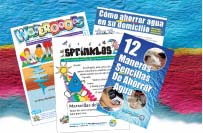Hispanic Outreach
Nearly 10 percent of the people who live in the District are Hispanic, and for many, Spanish is their first language. To reach that audience with a water conservation message, the District developed the Hispanic Outreach Program.

The idea behind the campaign began with the Governing Board’s Diversity Committee, said project manager John Walkinshaw.
Spanish-speaking District employees also showed an interest in promoting the outreach. Alberto Martinez, an environmental manager with the District’s Tampa Regulation Department, was interested in the program because of his Spanish background.
“I felt it was a good idea to have an outreach program because there is an interest in the Hispanic community to participate. It would be easier for some people to do that if they could receive the information in their native tongue,” Martinez said.
Work on the campaign really got off the ground after Walkinshaw attended a meeting on media messaging with members of the state’s other water management districts.
“I started talking to the Hispanic outreach coordinator from South Florida and went from there,” Walkinshaw said. “Its been slow going, taking one step at a time, but we now have some material out there.”
The Hispanic Outreach Campaign encompasses radio, TV and print media. The District’s popular “Frog” public service announcement has been translated into Spanish and is airing on Telemundo and Univision in the Tampa Bay area. Public service announcements are also airing on Hispanic radio stations.
The print portion of the campaign is taking a little longer. One of the biggest translation difficulties is that Spanish has different context, meaning and slang depending on different parts of the world. While Spanish is one language, there are regional and cultural differences in expression. This is similar to English, which sometimes can vary from the United Kingdom, United States, Canada, Australia and other locations.
“When we are translating we are looking for a common denominator and sometimes we can’t make it perfect for everyone,” Walkinshaw said.
Martinez has helped translate District brochures, but says translating materials takes time — time District employees who can speak Spanish may not have because they are busy with their job duties. That’s one reason the District turned to the translation service the South Florida and the St. Johns River water management districts use. A committee made up of District employees reviews the materials when they come back from the translation service.
So far, at least three District brochures and three Youth Education tabloids have been translated into Spanish. The brochures include “12 Simple Ways to Save Water,” “Saving Water Indoors,” and “Saving Water Outdoors.” The Youth Education tabloids include “WaterDrops,” a newsletter for students grades 3–9, and “Sprinkles,” a newsletter for younger children.
Other outreach activities included Tampa Bay Mutiny Soccer Outreach and Martinez making appearances on Hispanic TV and radio programs.
Future plans for the outreach program include finding additional bilingual spokespersons and increasing District speaking engagements. The spring will also see new radio and print PSAs translated into Spanish as well.
